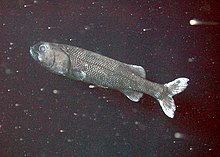Argentiniformes
| Argentiniformes | |
|---|---|
 |
|
| California slickhead, Alepocephalus tenebrosus (Alepocephaloidei: Alepocephalidae) |
|
| Scientific classification | |
| Kingdom: | Animalia |
| Phylum: | Chordata |
| Superclass: | Osteichthyes |
| Class: | Actinopterygii |
| Subclass: | Neopterygii |
| Infraclass: | Teleostei |
| Superorder: | Protacanthopterygii |
| Order: | Argentiniformes |
| Families | |
| Synonyms | |
|
|
The Argentiniformes are an order of ray-finned fish whose distinctness was recognized only fairly recently. In former times, they were included in the Osmeriformes (typical smelt and allies) as suborder Argentinoidei. That term refers only to the suborder of marine smelts and barreleyes in the classification used here, with the slickheads and allies being the Alepocephaloidei. These suborders were treated as superfamilies Argentinoidea and Alepocephaloidea, respectively, when the present group was still included in the Osmeriformes.
They contain six or seven families with almost 60 genera and at least 228 species. A common name for the group is marine smelts and allies, but this is rather misleading since the "freshwater" smelts of the Osmeridae also live predominantly in the ocean.
The Argentiniformes are smallish silvery or dark and generally bathypelagic ocean fishes. Some Argentinoidei have an adipose fin, which is – unusually for Protacanthopterygii to which they belong – missing in the rest of the order. The dorsal fin is located in the second half of the body. They have a physoclistous gas bladder or lack it entirely; teeth are absent in almost all.
The hypaxial muscle is unusually extended to forward at its upper end and attaches to the neurocranium below the spine, perhaps to snap the upper part of the skull down when catching prey. The primordial ligament attaches posteriorly on the upper surface of the coronoid process. The autopalatine is peculiarly expanded to above and below at its caudal end, and like in some , the caudal part of the mesethmoid appears compressed when seen from above. As in many other teleosts, the autopterotic and dermopterotic bones are not fused together. The most distinctive characteristic, however, is the crumenal organ, also called epibranchial organ. This consists of the additional cartilage and gill rakers on the fifth ceratobranchial, which is found in other teleosts, too, but not as well-developed as in the present order.
...
Wikipedia
